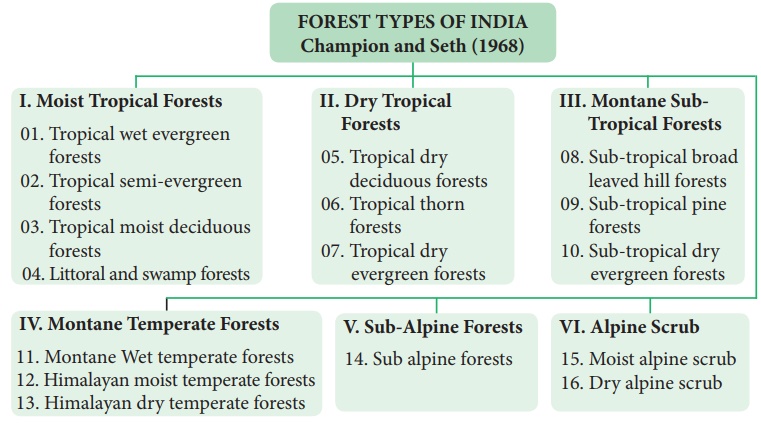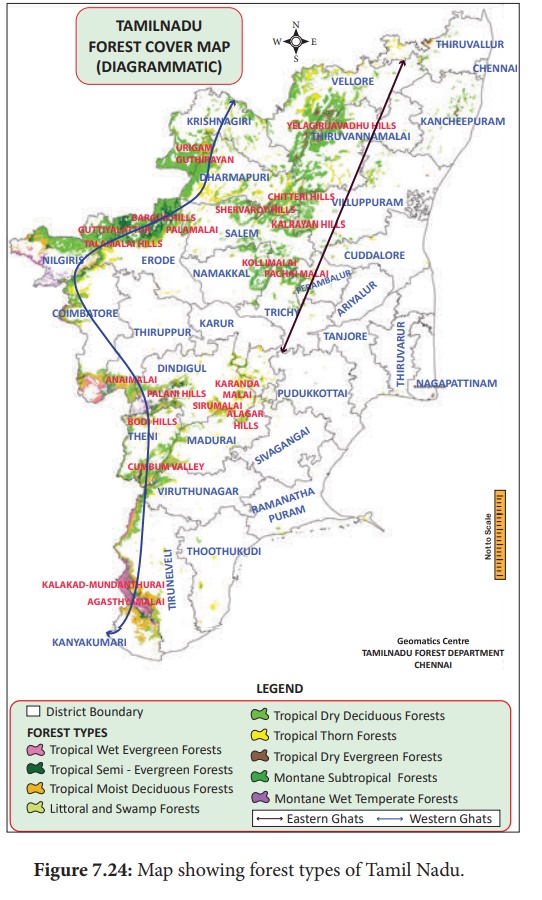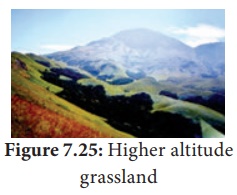Ecosystem - Vegetation types of India and Tamil Nadu | 12th Botany : Chapter 7 : Ecosystem
Chapter: 12th Botany : Chapter 7 : Ecosystem
Vegetation types of India and Tamil Nadu
Vegetation
Vegetation refers to the plant cover of an area. Geographically,
India is a tropical country and also has strong monsoon climate and differs from
other tropical regions of the World. India has four major climatic regions such
as wet zone, intermediate zone, dry zone and arid zone, These regions are
characterized by different types of natural vegetation. Nature of vegetation is
also determined by several factors like altitude, types of plants, animals,
climate, soil type, etc. Vegetation in Indian sub-continent is influenced by
biotic factors and the existing human culture for a long time. The influence of
man on plant formation and distribution is called anthropogenic effect on
vegetation.
Tamil Nadu has a rich biodiversity right from the Gulf of Mannar
to Western Ghats. Tamil Nadu shares the Western Ghats with states of Kerala,
Karnataka, Goa, Maharashtra, Gujarat while Eastern Ghats is shared with the
State of Andhra Pradesh. Of the 10 geographic zones in India, Coramandel (or)
East Coast and Western Ghats are from Tamil Nadu.
Vegetation types of India and Tamil Nadu
Vegetation of India and Tamil Nadu consists of variety of plant
communities and also possesses rich bio-diversity. It is classified in to the
following four types, Which are explained with reference to their unique
characteristics and distribution in India and Tamil Nadu:
1. Forest vegetation
2. Grassland vegetation
3. Riparian vegetation
4. Aquatic and semi aquatic vegetation
1. Forest Vegetation
Champion and Seth (1968) recognized a total of 16 forest types in
India, Whereas 9 types of them in Tamil Nadu.
I) Moist Tropical Forests
It is in the warmer plains. It is characterised by very dense,
multi-storeyed diverse trees, shrubs, lianas and scrub jungles. These areas
experience a high rainfall and dry climate. These are further classified into
the following types on the basis of wetness.
1. Tropical wet evergreen forests
This type is found at an altitude of nearly 1500 m on the slopes
of hills and mountains .These are also called tropical rain forests or tropical
wet evergreen forests, where annual rainfall is more than 250 cm.. Vegetation
consists of luxuriantly growing huge trees of more than 45 m in height, shrubs,
lianas and abundant epiphytes. The common plants are Dipterocarpus,
Artocarpus, Mangifera, Emblica and Ixora. These forests occur
in Andaman and Nicobar Islands, Western Coasts, Anamalai hills and Assam. This
type is also found in western ghats of Thirunelveli, Kanyakumari, Anamalai
Hills of Tamil Nadu
2. Tropical semi-evergreen forests
This type occurs on the slopes of hills and mountain usually up to
1000 m altitude.The annual rainfall in these forests is between 200 to 250 cm.
Vegetation consists of luxuriantly growing evergreen species of giant trees and
shrubs. The common tree species are Terminalia, Bambusa, Ixora,
Artocarpus, Michelia, Eugenia, and Shorea. Orchids, ferns, some
grasses,and herbs are also dominant. These forest are found in Western Coasts,
Eastern Orissa and Upper Assam. This type is also present in Coimbatore,
Thirunvelveli and Kanyakumar District of Tamil Nadu
3. Tropical moist deciduous forests
The annual rainfall of these forests is 100 to 200 cm with short dry periods. These are spread over an extensive part of the country. Many of the plants shed their leaves in hot summer. Some are ever green and semi-evergreen.

The common plant species are Terminalia, Grewia, Adina, Melia, Albizzia, Dalbergia and Shorea. The most
dominant plants are Tectona and Sal. These are found in Kerala,
Karnataka, South Madhya Pradesh, northern parts of Uttar Pradesh, Bihar,
Bengal, Orissa and Assam. This type is also present in Kanyakumari, Theni,
Gudalur, Dindigul, Madurai and Nilgiris of Tamil Nadu.

4. Littoral and swamp forests
These include beach forests, tidal forests, mangrove forests and
fresh water swamp forests.
a. Beach forests
These are found all along the sea coasts and river deltas. These
areas have sandy soil which consists of large amount of lime and salts but poor
in nitrogen and other mineral nutrients. The rainfall varies from 75 cm to 500
cm with moderate temperature. The common tree species are Casuarina,
Borassus, Phoenix, Pandanus , Morinda and Thespesia with many
twiners and climbers.
b. Tidal or mangrove forests
Tidal forests grow near the estuaries, swampy margins of islands and along sea coasts. The plants are
halophytes characterized by the presence of stilt roots, pneumatophores and
viviparous germinations of seed. The common plants are Rhizophora,
Avicennia, and Sonneratia. These are found near sea
coast,Gujarat, Ganges, delta regions of Mahanadhi, Godavari, Krishna,
Sundarbans and Pulicat, Pichavaram, Ramanathapuram of Tamil Nadu.
c. Fresh water swamp forests
These forests grow in low lying land areas where rain or river
water gets collected for some time. So the water table is closer to the earth
surface. The common plants are Salix, Acer, Ficus and all
varieties of grasses and sedges. These forests are found in wetlands of
Kanchipuram, Kanniyakumari of Tamil Nadu.
II. Dry Tropical Forests
These are classified into three types: Tropical dry deciduous forests,
tropical thorn forests and tropical dry evergreen forests
5. Tropical dry deciduous forests
These forests are found at about 400 to 800 m MSL .These forests
are found in the areas where annual rainfall is usually low, ranging between 70
and 100 cm. The largest forest area of the country is occupied by tropical dry
deciduous forest. The dry season is long and most of the trees remain leafless
during this season. The forest trees are not dense, and grow up to 10 to 15 m
in height. The common plant species are Dalbergia, Diospyros, Terminalia,
Acacia, Chloroxylon, Bauhinia and Zizyphus. Some common
Climbers are Combretum, Hiptage: herbs like Abutilon, Achyranthes
and Tribulus. These are found in Andhra Pradesh, Punjab, Uttar Pradesh,
Bihar, Orissa, Madhya Pradesh and also found in all districts of Tamil Nadu at
lower elevations.
6. Tropical thorn forests
These forests extend from plains upto 400 M . Occur in the areas
where annual rainfall is between 20 and 70 cm. The dry season is hot and very
long. The vegetation is of open type consisting of small trees (8 to 10 m
length) and thorny or spiny shrubs with a stunted growth. The plants remain
leafless for most of the year and many species have latex.. In rainy season,
there is a luxuriant growth of ephemeral herbs and grass. The most common plant
species are Acacia, Cassia, Calotropis, Albizzia, Zizyphus, Dichrostachys,
Euphorbia, Capparis, and including unpalatable species. They
are found in Karnataka, Andhra Pradesh, Maharashtra, South Punjab, most parts of
Rajasthan and part of Gujarat and Thirunelveli in Tamil Nadu.
7. Tropical dry evergreen forests
This type of vegetation is found in areas where annual rainfall is
in plenty but the dry season is comparatively longer. The trees are dense,
evergreen, short and about 10 to 15 meter height. The common plant species are Manilkara
, Walsura, Diospyros and Memexylon
These types of forests are found in the eastern parts of Tamil
Nadu, East coat of Andhra pradesh. They are also found in all coastal districts
in Tamil Nadu from Thiruvallur to Nagapatinum districts.
III. Montane Subtropical Forests
This type of vegetation occurs in the areas with fairly high
rainfall but where the climate is cooler than the tropical and warmer than the
temperate forests. They are found in the altitude between 1000 m and 2000 m.
The common plants are Eugenia, Syzygium and Toona are mostly
evergreens. Many epiphytes including orchids and ferns are present. These are
found in Nilgiri, Mahabaleswar, Assam and Manipur. In Eastern Ghats,it is found
in the upper slopes and plateau of shervaroys, Kollimalai and Pachamalai of
Tamil Nadu
These are further classified into
8. Sub-tropical broad
leaved hill forests (Tamil Nadu,Kerala,Karnataka and Assam).
9. Sub-tropical pine
forests (Punjab,
U.P and a part of Sikkim)
10.
Sub-tropical dry evergreen
forests (Shivaliks
and foot hills of western Himalayas).


IV. Montane Temperate Forests
This type of vegetation occurs where humidity and temperature are
comparatively low. These forests are very dense with an extensive growth of
grass and evergreen trees of 15 – 45 meters tall. The common plants are Artocarpus,
Balanocarpus, Pterocarpus, Myristica and woody climbers besides
ferns and epiphytes. It is also called mountain wet temperate forests. They are
found in mountains of Himalayas. These are further classified into
11.
Montane wet temperate
forests.
12.
Himalayan moist temperate
forests.
13.
Himalayan dry temperate
forests.
In Tamil Nadu montane forest is mostly confined to moist and
sheltered valleys, glens and hollows as in the Anamalis, Nilgiri and Palani
hills tops at above 1000 m. They are known in Tamil as ‘Sholas’. The common
vegetation of sholas are Ilex, Syzygium, Michelia, Eurya and Rhododendron.
V. Sub-Alpine Forests
14 Sub-Alpine Forests
This type of vegetation is found in the altitude ranging between
2900 m to 3500 m, where snow fall occurs for several weeks in a year with less
than 65 cm annual rainfall. Hence, strong winds and below 00 C temperature
prevail for greater part of the year. The common tree species are Abies,
Pinus, Betula, Quercus, Salix, Rhododendron with plenty of epiphytic
orchids ,mosses and lichens. They occur in Himalayas from Ladakh in the
West to Arunachal in the East Bengal, Uttar Pradesh, Assam, Jammu and Kashmir.
VI Alpine - Scrub
This type of vegetation is found in the Himalayas at an altitude
ranging from 3600 m to 4900 m. The height of the trees decreases with
increasing altitudes. The common plants are small sized plants such as Sedum,
Primula, Saxifraga, Rhododendron , Juniperus and with many
types of lichens. These are further classified into
15.
Moist alpine scrubs
16.
Dry alpine scrubs.
2. Grass land vegetation
Grassland refer to the vegetation community predominated by
graminoids (i.e. grass and grass like plants). These are found in the altitude
ranging from 150 to 2000 m and above mean sea level. The major plant families
of the plants are Poaceae, Cyperaceae, Fabaceae , Gentianaceae and Asteraceae
are common in this type of vegetation. The grass land not only comprises plants
but also serves as habitats to a variety of micro and macro fauna. Based on the
range of altitude, grasslands are categorized into: low altitude grasslands and
high altitude grasslands.
a. Low altitude grasslands
This type of grasslands are found at an altitude upto 1000 m. The
common plant species are Halopyrum, Wild Saccharum, Arundinella,
Heteropogon and Chrysopogon. These types of grasslands are
spread over coastal areas, riverline and alluvial areas of Deccan plateau,
Chota Nagpur plateau, Gangetic, Brahmaputra valley and Eastern Ghats.
In Tamil Nadu, these are found in the Eastern Ghats .These are
scattered and intermixed with local forests. They are exposed to considerable
biotic interference. Fire is common during dry months.
b. Higher altitude grasslands
This type of grasslands are found in altitude above 1000 m.The
common plants species are Chrysopogon, Arundinella, Andropogon, Heteropogon,
Cymbopogon, Imperata, Festuca, and Agrostis.. It is spread over the
southern slopes of Himalayas, sub-Himalayan ranges, Nagaland, Himachal Pradesh and Western
ghats.

In Tamil Nadu ,these grasslands are found in higher regions of
western ghats and are found between the sholas forest patches that occur in the
depressions and furrows created by water courses flowing in these rolling downs
are called as rolling grassland and also called shola grassland.
It shows different types of vegetation like grasses, herbs, few shrubs
and stunted trees.
3. Riparian Vegetation
This type of vegetation is located along streams and rivers. The
most common species are, Terminalia, Diospyros,Salix,Ficus and
grasses. They are found on the banks of Godavari, Krishna, Ganga,
Brahmaputria, Narmadha Yamuna and riverbeds of Cauvery and Thamirabharani in
Tamil Nadu.
4. Aquatic And Semi-Aquatic Vegetation
This type of vegetation is found in lakes, ponds, puddles and
marshy places. The common plant species are Nelumbo, Nymphaea, Bacopa,
Typha, Pandanus, Cyperus, Aeschynomene, Hydrilla, Aponogeton and
Potomogeton. It is found in various parts of Tamil Nadu.
Related Topics